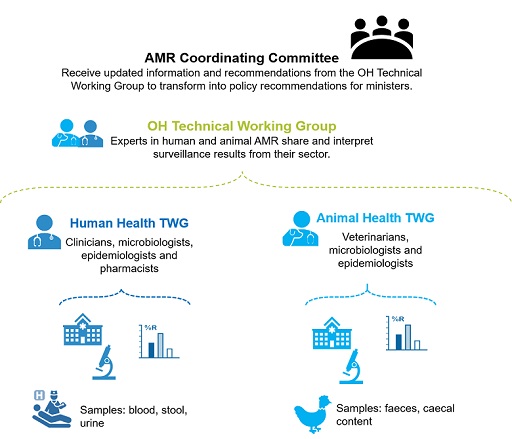8 One Health AMR surveillance programmes
You will learn more about bacterial AMR surveillance in the following modules:
- An introduction to AMR surveillance
- Introducing AMR surveillance systems
- An overview of national AMR surveillance
- AMR surveillance in animals.
Here we will just introduce the concept of a One Health approach to AMR surveillance.
What is One Health AMR surveillance?
One Health AMR surveillance:
- is a multi-sectoral surveillance programme to detect and monitor trends in ARB and/or ARG that contribute to AMR in multiple sectors
- generally focuses on measuring resistance to a common set of antimicrobials in a common set of
zoonotic bacteria in humans, animals and/or food products and environmental compartments such as water or soil - helps to identify ARB and/or ARG in humans that have spread from animals and the pathways by which they have been transmitted
- may focus on investigating the role of the environment in transmitting ARB and ARG that occur only in humans or only in animals.
In addition to this specific focus on ARB and/or ARG that may contribute to resistance in multiple sectors, multi-sectoral sharing of each sector’s broader AMR surveillance results helps the multi-sectoral AMR Technical Working Group (TWG) and the AMR Coordinating Committee (AMRCC) understand the multi-sectoral epidemiology of AMR in their country. This broader understanding is important for building a multi-sectoral approach to managing AMR.
Figure 3 shows an example of a One Health AMR surveillance programme involving the human health and animal health sectors, with each sector sharing and interpreting their combined surveillance results, using them to update the AMRCC with information generated through surveillance, and recommendations for policy and programmes. The programme can include other sectors such as the environment and/or food quality management as these sectors become engaged.

The aims of One Health AMR surveillance are to:
- identify the ARB and/or ARG that are transmitted between humans, animals, aquatic species and/or plants
- contribute to an understanding of pathways by which the ARB and/or ARG are transmitted between populations in the different sectors
- provide data for assessments of the public health risk of zoonotic ARB and/or ARG that are transmitted to humans and the effect of possible intervention measures
- monitor trends in ARB and/or ARG that are transmitted between populations in the different sectors.
- evaluate interventions aimed at reducing the emergence and/or transmission of ARB and/or ARG within and between populations.
It should be noted that One Health AMR surveillance should be conducted in conjunction with One Health AMU surveillance so that information on AMU is used to inform the design of AMR surveillance, and feeds into the interpretation of AMR data.
There are examples of effective One Health AMR surveillance programmes in a number of countries, including the Canadian CIPARS programme described in Section 4.1 that was responsible for detecting the transmission of ceftiofur-resistant S. Heidelberg from broiler chickens to people via the food chain. CIPARS monitors trends in AMU and AMR in selected bacterial organisms from human, animal and food sources across Canada. (More information can be found on the Canadian government’s website [Tip: hold Ctrl and click a link to open it in a new tab. (Hide tip)] (Government of Canada, 2006).)
As yet there are no examples of effective One Health Bacterial AMR surveillance systems in low- and middle-income countries, which is a major reason for the Fleming Fund programme supporting their development and implementation in a range of countries.
What makes a One Health AMR surveillance system ‘One Healthy’?
We suggest the following points:
- Surveillance includes AST of a common set of antimicrobials, using a common set of standards, in a common set of bacteria in samples from multiple sectors, e.g. from humans, animals and/or food and water from the environment.
- Common AMR patterns in samples from the different sectors are further investigated (e.g. using molecular and epidemiological methods) to provide evidence of transmission of resistant bacteria between the different sectors.
Activity 8: AMR surveillance and you
How does your role contribute to AMR surveillance? Do you meet with colleagues from other sectors to discuss AMR surveillance results?
7 National multi-sectoral organisations that address AMR



